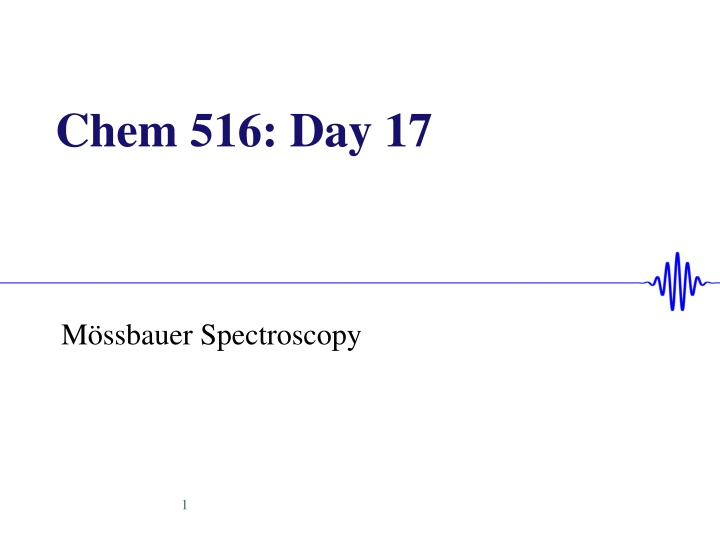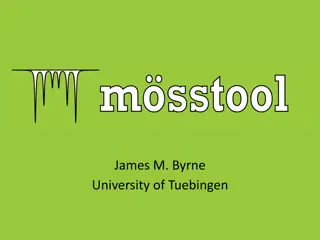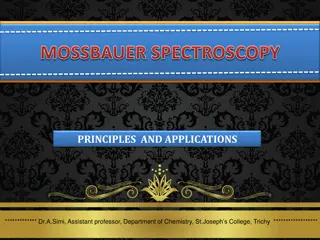
Exploring Mossbauer Spectroscopy: Nuclear Spin Dynamics and Excited States
Delve into the world of Mossbauer Spectroscopy through the lens of nuclear spin dynamics and excited states, uncovering the importance of resolution in spectral measurement and the impact of electron density on atomic nuclei sizes and energy states.
Download Presentation

Please find below an Image/Link to download the presentation.
The content on the website is provided AS IS for your information and personal use only. It may not be sold, licensed, or shared on other websites without obtaining consent from the author. If you encounter any issues during the download, it is possible that the publisher has removed the file from their server.
You are allowed to download the files provided on this website for personal or commercial use, subject to the condition that they are used lawfully. All files are the property of their respective owners.
The content on the website is provided AS IS for your information and personal use only. It may not be sold, licensed, or shared on other websites without obtaining consent from the author.
E N D
Presentation Transcript
Chem 516: Day 17 M ssbauer Spectroscopy 1
Hey Josh, dont forget: Post next homework Post answer keys Scan Que Announce final project plan 2
Pre-class problem: what resolution do we need for our spectra Fig credit: Joe Nugent s thesis How finely do I need to measure the spectrum? Are data points every 10 cm-1 good enough? 1 cm-1? 0.1 cm-1? 0.01 cm-1? 3
What about for UV/Vis, or EPR? JACS. 1996, 118, 36, 8692 4
Lets tally it up Method IR UV/Vis EPR E 3000 cm-1 25,000 cm-1 3000G or 2.000 (in g) 10,000 eV E 1 cm-1 60 cm-1 3-4 or .001 E/E 10-3-10-4 10-3 10-3 X-ray 0.1-1 eV 10-5 - 10-4 The importance of this will become apparent later, trust me 5
Recap on nuclear spin: 1H, I=1/2 mI = -1/2 E mI = 1/2 H This is the same drawing I used for EPR, but now for NUCLEAR spins, not electron spins (note: for I, positive mI is lowest energy) 6
But, we were only talking about the GROUND nuclear state! Nucleus Spin 1 1 7/2 3/2 1H 2D 14N 31P 57Fe 59Co 63,65Cu 7
Nuclei can have excited states too! 57Fe I=7/2 136 keV I=3/2 14.4 keV h I=1/2 0 eV Note: we are changing I, not mI 8
Atomic nucleus takes up space, and that size depends on the spin 57Fe, I=1/2 57Fe, I=3/2 n n P P P P n P P P n n n n n P P P (size difference exaggerated) Some points to consider: 1. Different I have different sizes 2. The protons in the nucleus have an attractive interaction with the electron density at the nucleus 3. Only the s orbital has electron density at the nucleus 4. Therefore the energy of each I state will depend on the s-orbital electron density. 9
Mossbauer measures s-electron density Some points to consider: 1. Different I have different sizes 2. The protons in the nucleus have an attractive interaction with the electron density at the nucleus 3. Only the s orbital has electron density at the nucleus 4. Therefore the energy of each I state will depend on the s-orbital electron density. Molecule 1 Molecule 2 I=3/2 I=3/2 I=1/2 I=1/2 Key point: the I=1/2 state is more sensitive to e- density than the I=3/2, so the two levels change by different amounts when the molecule changes. The transition energy is therefore molecule-specific! 10
The equation for isomer shift between molecules A and B S-orbital wavefunctions at radius=0 =2 2 ?(0)? 2 ??2 ??2 3???2 ?(0)? Nuclear charge Excited and ground-state radii =2 2 ?(0)? 2 3???2 ?(0)? ?2 For 57Fe, this is negative 11
Group problem! How would you expect the isomer shift to change between FeF2, FeBr2, FeCl2, and FeI2? FeCl2 Some logical axis of your choice 12
Group answer: start with Cl vs F =2 2 ?(0)?? 2 3???2 ?(0)? (?2) Compared to Cl, F is more electronegative, so it pulls electrons away from the Fe. ?(0)? (?2) is also negative, so is positive 2 is therefore smaller than ?(0)?? 2, so the bracket term is negative. Less e- at nucleus FeF2 FeCl2 FeBr2 FeI2 More e- at nucleus Electronegativity 13
What about oxidation state? Less e- at nucleus Image from Karsten Krebs More e- at nucleus I II III IV V Oxidation state 14
Symmetry also matters Molecule 1 Molecule 2 mI = 3/2 ??? ??? ??? I=3/2 ?? mI = 1/2 Electric field gradient along x/y/z axis I=1/2 mI = 1/2 Isomer shift Quadrupole splitting 15
Lets summarize measures s-electron density at nucleus eq measures the asymmetry of the molecule 16
So what should that look like ? Molecule A: Fe(IV), almost Oh Molecule B: Fe(II), very D4h A B Transmission EqB EqA 14,400 eV 17
But here comes the problem A B Transmission EqB EqA 14,400 eV and Eqare on the order of 10-9 eV! How the heck do you make a source that can tune from 14,399.999999999 to 14,400.000000001 eV? 18
Step 1: use a reference emitter 57Co 57Fe I=7/2 136 keV h I=3/2 14.4 keV h I=1/2 0 eV 19
Step 1: use a reference emitter Source Receiver I=3/2 I=3/2 57Fe I=1/2 I=1/2 20
Step 2: Use doppler shift to tune the energy Detector source receiver The source moves at a rate of a few mm/second, so that is how the X axis is labeled! 21
Some actual spectra 22 Note: standard reference is Na2[Fe(CN)5NO]
Spin also effects the isomer shift 23 Suslick et al, Inorg Chem, 1983, 22, 367
The final oddity Let s imagine Source and Receiver as ice skaters on a rink: h Recoil She thought she threw a photon with energy E0, but its actual energy is Eh =E0-ER h Recoil If he can only catch photons with energy Eh , then the actual photon energy needs to be E0+ER ? 2 2??2, 10 3?? ??= 24
So this whole business should be impossible But, quantum mechanics comes to the rescue: in a solid, recoil is absorbed by molecular vibrations: ? ? ? = ?0 ? Normal modes How many quanta you excite, n=0,1,2, n can be 0! That means you can get recoil-less emission and absorption. A purely quantum phenomenon 25


